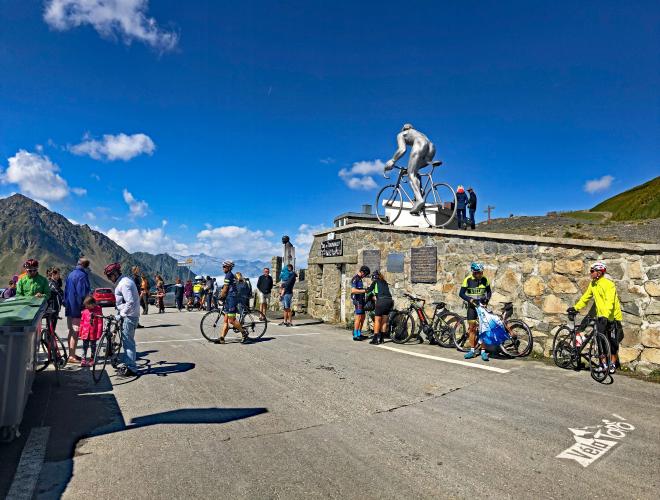![Cycling Col du Tourmalet from Sainte Marie de Campan large silver cyclist statue at top of the Col du Tourmalet bike climb]()
Cycling Col du Tourmalet from Sainte Marie de Campan
Ride 17 kilometers gaining 1,260 meters at 7.4% average grade.
Climb summary by PJAMM Cycling’s John Johnson.
Tourmalet made its record 88th appearance in the Tour de France as one of the HC climbs on stage 18, July 15, 2021. See more Tourmalet TdF history below.
![Cycling Col du Tourmalet from Sainte Marie de Campan photo collage at finish of Col du Tourmalet, PJAMM Cyclists pose with bikes at summit sign and in front of le geant statue]()
The second fiddle to Tourmalet West from Luz-Saint-Sauveur? Perhaps, but in its own right a bucket list climb. Although admittedly less scenic and just a bit less challenging, this climb must be included, along with Tourmalet West, on any advernterous cyclist’s bucket list. This route is predominantly used by auto to reach the La Mongie ski resort. There is as much cycling traffic on this col as you will see on any other, save perhaps Alpe d’Huez, Ventoux, and Stelvio. Although there is slightly less distance and elevation gain to this side of the mountain, we very much enjoyed our climb and highly recommend it.
START OF THE CLIMB
![Cycling Col du Tourmalet from Sainte Marie de Campan PJAMM Cyclists pose at climb start]()
Begin the climb in Sainte Marie de Campan, Hautes - Pyrenees (pop. 1,388 2016).
SCENES ALONG THE WAY
![Cycling Col du Tourmalet from Sainte Marie de Campan L’Adour d’Arizes at km 7.7 and L’Adour du Tourmalet at km 7.9; overlooking waterfall]()
L’Adour d’Arizes at km 7.7 and L’Adour du Tourmalet at km 7.9.
![Cycling Col du Tourmalet from Sainte Marie de Campan photo collage shows French Pyrenees views along the middle portion of the climb]()
Views along the middle section of the climb.
![Cycling Col du Tourmalet from Sainte Marie de Campan Eugène Christophe poster at kilometer 10]()
Eugène Christophe poster at kilometer 10 (see story under TdF History, below).
![Cycling Col du Tourmalet from Sainte Marie de Campan 250 meter cantilevered snow roof]()
There is a 250 meter cantilevered snow roof beginning at kilometer 10.7, and a two-section graffiti galleria (snow tunnel with openings) of 300 meters beginning at kilometer 11.7. Both are below the ski resort town of La Mongie.
![Cycling Col du Tourmalet from Sainte Marie de Campan photo collage shows ski resort town of La Mongie, llamas grazing in pasture]()
We pass through the ski resort town of La Mongie for 700 meters at 8.1% beginning at kilometer 12.5. And, yes, those are llamas at the resort - at least in the summer.
![Cycling Col du Tourmalet from Sainte Marie de Campan views of roadway and mountain coming up to the climb's summit]()
It is three kilometers past La Mongie to the summit at an average grade of 9%.
KM MARKERS 16 TO 1
![Cycling Col du Tourmalet from Sainte Marie de Campan kilometer markers along the route]()
Photos clockwise from top left: km 16 = 4%; km 15 = 3%
km 14 = 4%; km 13 = 7%.
Note: “km” means how many kilometers to the finish.
![Cycling Col du Tourmalet from Sainte Marie de Campan kilometer markers along the route]()
Photos clockwise from top left: km 12 = 9%; km 11 = 8%
km 10 = 9%; km 9 = 9%
![Cycling Col du Tourmalet from Sainte Marie de Campan kilometer markers along the route]()
Photos clockwise from top left: km 8 = 10% (steepest km); km 7 = 9%;
km 6 = 9%; km 5 = 9.5%
![Cycling Col du Tourmalet from Sainte Marie de Campan kilometer markers along the route]()
Photos clockwise from top left: km 4 = 7.5%; km 3 = 9%
km 2 = 9.5% and km 1 = 9.5%
WEATHER
![Cycling Col du Tourmalet from Sainte Marie de Campan PJAMM Cyclists ride on roadway surrounded by hard packed snow in June 2013]()
. . . just below the top in June, 2013 - yes, June!
Generally, the weather should be fine for you from June through September. But, in 2013 we ran into snow in mid-June, then we had 100 degree heat in July 2022.
FINISH - COL DU TOURMALET
![Cycling Col du Tourmalet from Sainte Marie de Campan aerial drone view shows summit, points out Tour de France sign and Geant au Col du Tourmalet statute]()
![Cycling Col du Tourmalet from Sainte Marie de Campan views at climb summit, including large silver cycling statue]()
The finish at Col du Tourmalet is, along with Passo dello Stelvio, is the most vibrant, fun, and busy cycling summit in the world.
TOUR DE FRANCE HISTORY
![Cycling Col du Tourmalet from Sainte Marie de Campan Tour de France signs at summit]()
TOP 10 MOST FREQUENT CLIMBS OF THE TOUR DE FRANCE
AND 10 FAMOUS ONES AFTER THAT
As of 2022, Col du Tourmalet has been featured in more TdFs than any other climb.
© PJAMMCycing.com
With Alpe d’Huez, Col du Tourmalet is a tour and world legend. This is the highest pass in the Pyrenees and, as of 2022, has been included in the Tour de France a record 89 times between its first appearance in 1910 and 2023. From 1919 to 1939, Tourmalet was included in the TdF every year except 1922, and then only because the tour rerouted due to heavy snow.
![Cycling Col du Tourmalet from Sainte Marie de Campan PJAMM Cycling’s Profile Tool analysis of 2021 Stage 18]()
PJAMM Cycling’s Profile Tool analysis of 2021 Stage 18.
55 km at 0-5% average grade, 23 km at 5-10% and 7.5 km at 10-15%
Steepest 500 meters is 12.1%, 1 km 11% and 2 km 9.8%
Although no other climb has appeared more times in the Tour, Tourmalet has only been the finish three times.
![Col du Tourmalet 1974 - Jean-Pierre Danguillaume]()
Jean-Pierre Danguillaume won the first stage to finish on Col du Tourmalet (1974).
Photo: deskgram.net.
Tourmalet has a rich TdF history that began with its very first appearance in The Tour. The legendary TdF organizer, Henri Desgrance had decided to include Tourmalet in the 1910 tour. The first rider over Col du Tourmalet on July 21, 1910 was eventual 1910 tour winner, Frenchman Octave Lapize. Lapize was overtaken on the next climb (Col d’Aubisque). At this time Lapize unleashed on tour organizers as he reached the pass -- this is not disputed -- what he said, however, is variously reported as either some or all of the following: “murderers,” “assassins,” and/or “criminals.” Sadly, Lapize was to die seven years later from injuries sustained when his fighter plane was shot down during WWI.
![Octavio Lapize - first cyclist over Tourmalet - 1910]()
Octave Lapize -- the first rider (hiker?) over Tourmalet, 1910.
Photo: Cycling Passion, Octave Lapize walks over the Col du Tourmalet.
The tour was not held from 1940-46 due to WWII. When The Grand Tour reappeared in 1947, so to did Tourmalet. From 1947 to 1955 Tourmalet was featured in the TdF. It wasn’t until 1956 that Tourmalet was left off the Tour’s agenda without excuse; from 1919 to 1957 Tourmalet was included in the Tour every year that it occurred.
One of the most famous stories of Col du Tourmalet and the Tour de France is from 1913. Descending Tourmalet towards Campan, French cyclist Eugène Christophe crashed and broke his front fork. Showing the resilience and spirit of those times (and, lacking any support staff), Christophe walked down the east side of Tourmalet to Campan where he found a forge and amazingly repaired his bike sufficient to ride to the stage finish in Bagnères-de-Luchon. To add insult to injury, on top of already having lost three hours due to the crash, the race organizers penalized him for the “assistance” he was given by a seven year old boy who had pumped the bellows for him while he repaired his bike a blacksmith’s shop in Campan.
![Eugene Christophe - Tourmalet 1910]()
Eugène Christophe repairing his bike in Campan, 1913 (Image from Jean Durry).
YouTube summary of Christophe’s 1913 bad luck.
In 1919, Eugène Christophe became the first man to wear the yellow jersey.
In 2010 Alberto Contador and Andy Schleck battled up the Col du Tourmalet from Luz-Saint-Sauveur for a mountain top finish (the second straight day Tourmalet was featured in the tour and only its second mountain top finish ever). With ten kilometers to go, Schleck and Contador broke from the group and were alone on a fog shrouded ascent to the Col du Tourmalet. With two kilometers to go, the two raced up the mountain side by side in heavy fog and light rain, having tried to break each other multiple times over the past eight kilometers. Schleck led the entire final kilometer and there was no sprint at the finish, Contador conceding the stage to Schleck, but keeping the yellow jersey, both riders finishing with the same 5:03:29.
![Tourmalet - Schleck and Cantador]()
Andy Schleck edged Alberto Contador TdF 2010 stage 17.
Photo by filip bossuyt.
YouTube segment of Schleck and Contador on Tourmalet.
WHAT’S ON TOP?
![Col du Tourmalet Col du Tourmalet summit and col - photo of Le Geant]()
“Géant au Col du Tourmalet” -- Paying homage to the “Giants” of the road.
Velopeloton.com writes of the Géant:
“Géant au Col du Tourmalet is an iron sculpture first erected in 2000. It was created by the artist Jean-Bernard Métais, as part of the Tour de France sculpture on the A64 autoroute between Tarbes and Pau. This sculpture features 8 cyclists, Le Géant is the 9th person of the work. Le Géant is installed at the summit on the first Saturday of June each summer. It is a great occasion known as “Montée du Géant” – “Rise of the Giant” and attracts approx 1000 cyclists, who ride up the mountain with Le Géant. Le Géant travels on the back of a truck, accompanied by a brass band. There is a celebrity cyclist each year, with Bernard Hinault and Miguel Indurain among those who have honoured the Giant with their effort. Le Geant is removed at the beginning of October each year for safekeeping from the harsh winter. It is mostly on display in Bagneres de Bigorre, but has spent a couple of winters in Tarbes.
![Col du Tourmalet - Le Geant]()
Géant au Col du Tourmale
Photo: Velopeloton.com
There is a misconception doing the rounds in the last few years that it is a statue to honour Octave Lapize, who was the first Tour de France rider to cross Col du Tourmalet in 1910. It’s not. This seems to have arisen after a plaque commemorating the first crossing by Le Tour and Lapize was erected on the wall under Le Géant in 2010. The real purpose is . . . “is the homage of Hautes Pyrenees to the Giants of the road”. Interpret that as you wish. The giants of the road could be the riders of Le Tour de France or it could be all the riders who cycle up Col du Tourmalet each year. I prefer the latter. An honour for every cyclist who makes it to the top” (read more here).
![Col du Tourmalet - Le Geant Bike climb up Col du Tourmalet - col - bicycles and cyclists; Le Geant statue, col sign]()
One of the most famous cycling summits in the world.

 We've partnered with Sherpa-Map.com to bring you the best route planning tool. With a PRO Membership you can use this climb as a reference when creating your route.
We've partnered with Sherpa-Map.com to bring you the best route planning tool. With a PRO Membership you can use this climb as a reference when creating your route. 







